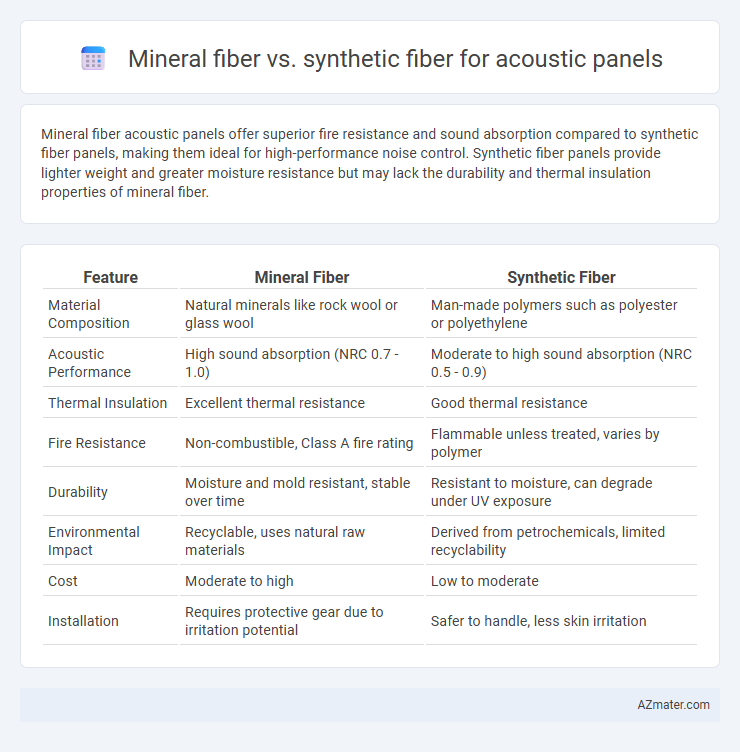Mineral fiber acoustic panels offer superior fire resistance and sound absorption compared to synthetic fiber panels, making them ideal for high-performance noise control. Synthetic fiber panels provide lighter weight and greater moisture resistance but may lack the durability and thermal insulation properties of mineral fiber.
Table of Comparison
| Feature | Mineral Fiber | Synthetic Fiber |
|---|---|---|
| Material Composition | Natural minerals like rock wool or glass wool | Man-made polymers such as polyester or polyethylene |
| Acoustic Performance | High sound absorption (NRC 0.7 - 1.0) | Moderate to high sound absorption (NRC 0.5 - 0.9) |
| Thermal Insulation | Excellent thermal resistance | Good thermal resistance |
| Fire Resistance | Non-combustible, Class A fire rating | Flammable unless treated, varies by polymer |
| Durability | Moisture and mold resistant, stable over time | Resistant to moisture, can degrade under UV exposure |
| Environmental Impact | Recyclable, uses natural raw materials | Derived from petrochemicals, limited recyclability |
| Cost | Moderate to high | Low to moderate |
| Installation | Requires protective gear due to irritation potential | Safer to handle, less skin irritation |
Introduction to Acoustic Panels
Mineral fiber and synthetic fiber are two primary materials used in acoustic panels to improve sound absorption and reduce noise levels. Mineral fiber panels, made from materials like rock wool or slag wool, offer excellent thermal insulation and fire resistance alongside superior soundproofing qualities. Synthetic fiber panels, typically composed of polyester or fiberglass, provide lightweight, moisture-resistant options with effective sound absorption tailored for various acoustic environments.
What Are Mineral Fibers?
Mineral fibers, commonly used in acoustic panels, are inorganic fibers derived from natural or synthetic minerals such as basalt, rock wool, and slag wool, known for their excellent sound absorption and thermal insulation properties. These fibers provide superior fire resistance and durability compared to synthetic fibers, making them ideal for high-performance acoustic treatments in commercial and industrial environments. Mineral fibers effectively trap and dissipate sound waves, reducing noise pollution and improving room acoustics with eco-friendly and sustainable materials.
What Are Synthetic Fibers?
Synthetic fibers, commonly made from petrochemicals, are engineered fibers such as polyester, nylon, and acrylic used in acoustic panels for their durability and moisture resistance. These fibers offer consistent acoustic performance, effectively absorbing sound waves while maintaining structural integrity under humidity and temperature fluctuations. Compared to mineral fibers, synthetic fibers are lighter and less prone to degradation, making them ideal for environments requiring long-lasting noise control solutions.
Acoustic Performance Comparison
Mineral fiber acoustic panels offer superior sound absorption, particularly in mid to high-frequency ranges, due to their dense and porous structure, which effectively reduces reverberation and noise levels. Synthetic fiber panels, such as fiberglass, provide strong acoustic performance with enhanced durability and moisture resistance, making them suitable for environments with variable humidity. Both materials excel in sound attenuation, but mineral fiber panels typically deliver higher NRC (Noise Reduction Coefficient) ratings, optimizing acoustic clarity in critical listening spaces.
Sound Absorption Capabilities
Mineral fiber acoustic panels excel in sound absorption due to their dense, porous structure that effectively traps and dissipates sound waves, particularly in mid to high frequencies. Synthetic fiber panels, often made from polyester, provide good sound absorption with the advantage of lightweight and moisture resistance but typically perform slightly lower in low-frequency absorption compared to mineral fibers. For optimal acoustic treatment, mineral fiber panels are preferred in environments requiring superior sound control and thermal insulation.
Durability and Longevity
Mineral fiber acoustic panels offer superior durability due to their resistance to moisture, fire, and biological growth, making them ideal for long-term applications in commercial and industrial settings. Synthetic fiber panels, while lightweight and flexible, may degrade faster under UV exposure and humidity, reducing their longevity in harsh environments. Choosing mineral fiber ensures enhanced acoustic performance over time, with less frequent replacement and maintenance compared to synthetic alternatives.
Environmental Impact and Sustainability
Mineral fiber acoustic panels, often made from natural materials like rock wool or glass wool, offer superior sustainability due to their recyclability and lower embodied energy compared to synthetic fibers composed of petroleum-based polymers. Synthetic fiber panels typically contribute to higher carbon emissions and generate microplastics during production and disposal, raising environmental concerns. Choosing mineral fiber solutions supports eco-friendly construction by minimizing pollutant release and enhancing indoor air quality through natural breathability and reduced off-gassing.
Installation and Maintenance
Mineral fiber acoustic panels are heavier and require more precise alignment during installation to ensure optimal sound absorption, often needing professional handling due to their brittleness and dust generation. Synthetic fiber panels are lighter, easier to cut and install with basic tools, and resist moisture and mold, making maintenance simpler and less frequent. Both materials benefit from periodic dusting, but synthetic fibers typically endure cleaning processes better without degrading their acoustic properties.
Cost Effectiveness
Mineral fiber acoustic panels typically offer greater cost-effectiveness due to their lower material costs and excellent sound absorption properties, making them ideal for large-scale installations. Synthetic fiber panels, while often more expensive, provide enhanced durability and moisture resistance, potentially reducing long-term maintenance expenses. Evaluating project-specific factors such as budget constraints and environmental conditions is essential to determine the most economical choice between mineral and synthetic fibers.
Conclusion: Which Fiber is Best for Acoustic Panels?
Mineral fiber offers superior sound absorption and fire resistance, making it a popular choice for acoustic panels in commercial and industrial spaces. Synthetic fibers provide greater durability, moisture resistance, and ease of installation, ideal for environments prone to humidity or requiring lightweight solutions. Choosing the best fiber depends on specific acoustic performance needs, fire safety requirements, and environmental conditions of the installation site.

Infographic: Mineral fiber vs Synthetic fiber for Acoustic panel
 azmater.com
azmater.com